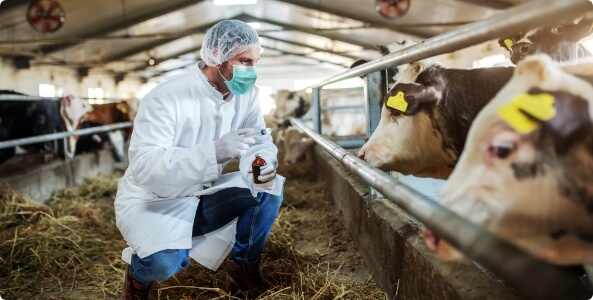
Ruminants
5 common diseases in livestock & how to treat them
The modern animal farming seen today is directly linked with the environment with many diseases no longer following the traditional pattern. Animals especially livestock are now increasingly dependent on mechanical equipment be it for feeding, removal of manure and even milching. This has resulted in a change in the characteristics of animal diseases.
We have found out the five most common diseases found in livestock and how to treat them.
-
-
Black Quarter (Black-leg)
A highly contagious lethal bacterial disease seen in cows, buffaloes, sheep, and goats is commonly seen during the rainy seasons. This soil-borne infection is sporadic and the organism that causes this black leg symptom is a bacterial disease called ‘clostridium chauvoei’.
Major symptoms:
- fever and loss of appetite
- depression and dullness
- suspended rumination
- difficulty breathing
- lameness in the affected leg
-
This highly contagious disease affects cloven-footed animals mainly. Animals that recover from the foot and mouth disease have indicated a rough coat and deformation of the hoof. Widely spread across India, Foot and Mouth disease in Animals is spread directly through infected water, manure, hay, and pastures.
Major symptoms:
-
-
- fever and lameness
- crossbred cattle are highly susceptible
- stringy saliva hangs from the mouth.
-
Treatment: TOPICURE ADVANCED
-
Mastitis
Mastitis is the inflammation of the mammary glands. One of the most common diseases found in dairy cattle across the world is caused through invading bacteria or other microorganisms such as yeasts, fungi, or other viruses.
Also, stress and physical injuries may cause inflammation in the glands. The microorganisms penetrate through the teat canal and multiplies in the mammary glands.
Treatment: WISPREC ADVANCED SPRAY
-
Ringworm
One of the most common infectious skin disease affecting cattle it is caused by fungi and can be transmissible to humans as well. To control the disease, it is recommended to segregate the affected animal from others.
Major Symptoms:
- Grey patches in the area of the head and neck and around the eyes.
Treatment: TOPICURE++
-
Milk Fever
It is a disease that is associated with the development of heavy milking cows. However, a decrease in ionised calcium levels is the cause of the disease. Milk Fever is usually observed in 5- to 10-year-old cows. as they undergo a sudden reduction in blood-calcium level 48 hours post-calving.
Major Symptoms:
- Hypocalcaemia
- hypophosphataemia
- variations in the concentration of serum-magnesium levels.
- loss of appetite, constipation, and restlessness
Treatment: Innocal Plus













Add your comment